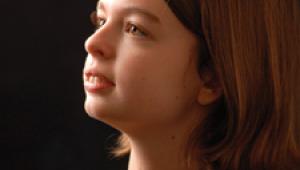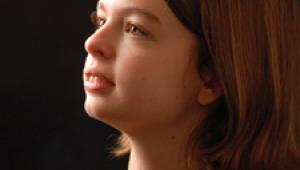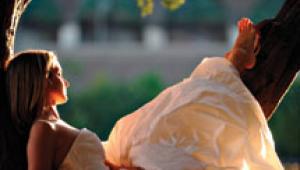Window Light; Interior Portraits Using Sunlight
One of the most beautiful, natural forms of illumination has to be window light. The warm rays of summer gently filtered through window glass or the cool light reflected off winter’s snow all create the ethereal glow that’s soft enough for portraits. The examples shown here are but a few of the myriad of possibilities.
As with all lighting examples shown here, a daylight-balanced flash does not enter the picture at all. The key source is light from the window with a reflector being the only fill.
 |
 |
|
|
||
Each one of these examples shows three important factors: let the color temperature set the “mood” of the shot; use soft window light’s strength by moving the subject closer to or farther from the source; and allow the amount of fill (reflector, not flash) to control the lighting ratio. Light and shadow work very well together—the key is deciding the ratio. Next time you see light cascading through a window, imagine someone gazing out into that light—you’ll be pleasantly surprised.
 |
Beginning with one of the most striking examples, stained glass, your subject will be bathed in multicolored hues of natural light. Jeana leans against a stained glass window in our school’s chapel. The key source of illumination is daylight filtered through the colored glass and a silver reflector opposite the window. As in Jeana’s case, placement near a stained glass window is critical unless you want patches of green or blue light appearing on your subject’s skin. I was careful to pose her so this was not a problem. (Nikon D3X, 24-70mm lens, f/4.5, 1⁄50 sec, ISO 400, white balance: 5000?K.
With Jordan, I chose our library where a wall of glass acts as backlight, another window camera left as the key, and a reflector camera right. A 3:1 lighting ratio gives Jordan some contrast and I allowed the snowy exterior to overexpose by three stops so the eye is pulled to her and not the background. The bright blue of her blouse does not hurt either. (Nikon D3X, 24-70mm lens, f/4.5, 1⁄100 sec, ISO 400, white balance: 5000?K.)
 |
Here, Corinne has the window side of her face being illuminated twice that of the reflector side. Because the lens is zoomed in, we are not seeing too much of the overexposed window light. Instead, we just get a soft glow, which is far more flattering. This shot might not have worked as well with someone with lighter hair because darker colors absorb light and lighter colors reflect. (Nikon D3X, 24-70mm lens, f/5.6, 1⁄320 sec, ISO 400, white balance: 5000?K.)
Michele has the coldness of the snow creating a blue cast on her face. This could have been easily warmed with a gold reflector, but using the silver side on camera right fashioned the look I was after. Here again, I find it helpful to have the subject turn her face to the brightest window light and move unnaturally close to the glass. The light filtering in through the window is ambient light, which keeps the lighting ratio even. (Nikon D3X, 24-70mm lens, f/5.6, 1⁄320 sec, ISO 400, white balance: 5000?K.)
For very dramatic lighting, Abbi sat on the window sill for this 5:1 lighting ratio. With Abbi close to the glass, the blown-out window light acts as the key, and a reflector 5 feet camera left provides a little bit of fill. The expression helps here because a big smile on her part would call for a higher key lighting ratio, in my opinion. A flash would have destroyed the look I was after even if it were highly diffused. (Nikon D3X, 24-70mm lens, f/4, 1⁄200 sec, ISO 400, white balance: 5000?K.)
 |
Shooting during the magic hour (when the color temperature is the warmest), make use of nature’s colors. With Abbi leaning on the window sill, I let the window overexpose so the softness of the curtains, the deep wood tones of the grandfather clock, and the spring colors of the flowers distract from the snow-enveloped exterior. Gelling the window with neutral density would have changed Abbi’s quality of light and brought the snow into range. (Nikon D3X, 24-70mm lens, f/3.5, 1⁄100 sec, ISO 400, white balance: 5000?K.)
 |
Chuck Gloman is the program director of the TV/Film department as well as a member of the faculty at DeSales University. He may be reached via e-mail at: chuck.gloman@desales.edu.
















































